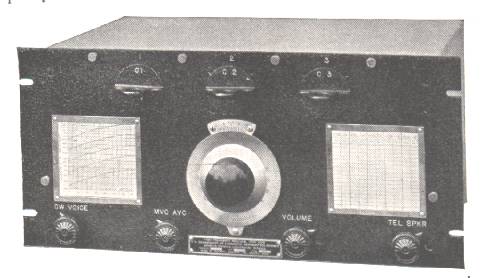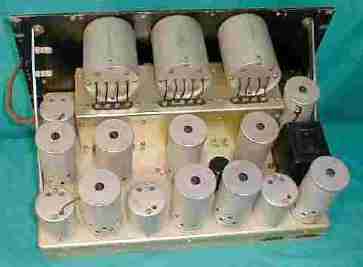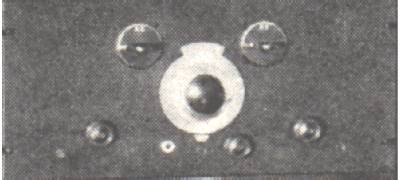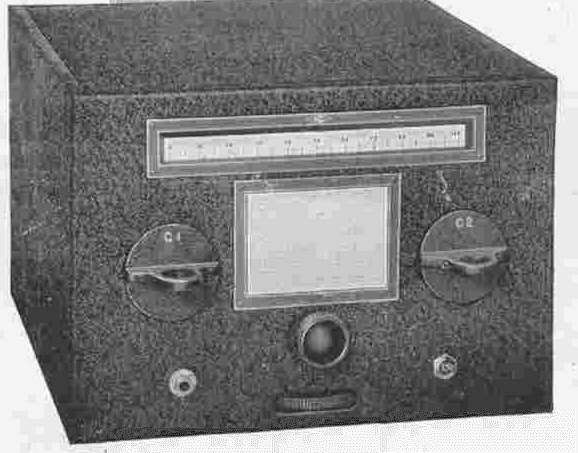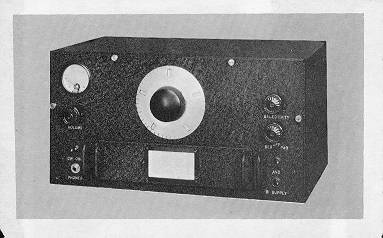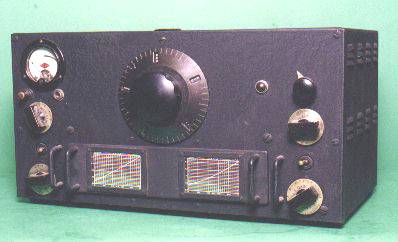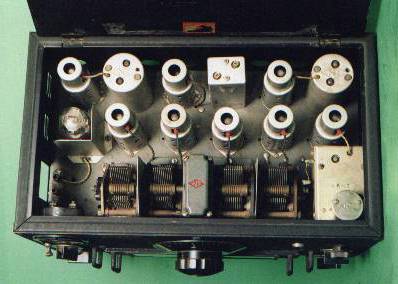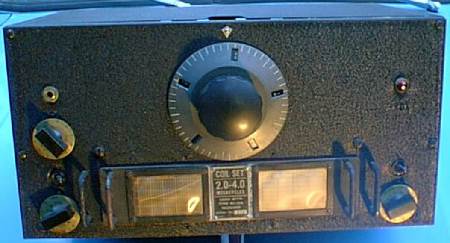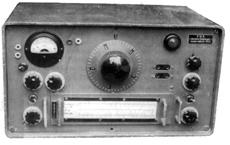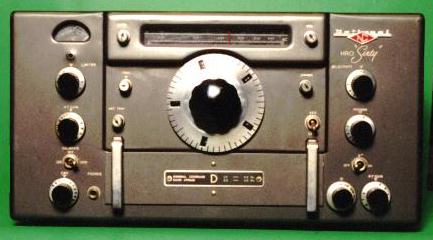In 1932 the General Electric Company was awarded a contract to supply the government’s Bureau of Air Commerce with shortwave transmitters and receivers for air safety. General Electric had developed the transmitters but did not have a receiver and approached Millen to have National develop one. The result was the Aeronautical Ground Station or AGS receiver. The AGS was a superhet receiver covering the range 1.5 to 20MHz. It had a single RF amplifier and two stages of IF amplification at 500kHz. It used 9 valves and five sets of pluggable coils with 3 individual coils in each set. The use of pluggable coils avoided the engineering difficulties of band switching and achieved reliable repeat tuning.
The AGS Receiver
Unlike the SW-3, 4 and 5, the AGS coils plug into individually screened compartments from the front panel of the receiver.
A super-regenerative receiver, the SW-58C was produced shortly afterwards as a companion to the AGS to cover the 200 to 400kHz range then in use by the airlines.
The SW-58C Receiver
The basic AGS cost $165. Wishing to maintain their position in the amateur radio market they released a cut down version of the receiver, the FB-7. With only seven valves, no RF preselector, a more economical mechanical construction and supplied with just one set of coils for the 80m band this cost $55.
The FB-7 Receiver
The technical problems encountered and overcome in designing the AGS and FB-7 paved the way for the HRO.
After the introduction of the AGS by the government for its ground stations, the airline industry itself began to recognise the increasing importance of radio communications. But the airlines were not entirely happy with the AGS and specified their own requirements through Herb Hoover, then in charge of radio communications for Western Airlines (later to became part of TWA) who acted as their spokesman.
They demanded better image rejection, improved selectivity, good AVC, an S-meter and high reliability. And if plug-in coils had be used then all coils for a band must plug in simultaneously.
To meet their specification, the National design had two rf amplifiers and two 455kHz IF amplifiers and included a 20Hz crystal filter. Millen designed the now famous epicyclic dial allowing the operator to read to one part in 500.
As with the AGS, National wanted to avoid the complexities of band switching and continued to use plug in coils but this time in the form of a four bank plug in coil pack. Each coil pack had its own calibration chart.
Recognising the potential amateur radio market for the receiver, each coil had two little screw holes which accepted a machine screw. Depending on the position of the screw you either got general coverage or just an amateur band spread over the whole dial. The screw just shorted or opened a condenser across part of the coil.
Through 1934 National worked on developing the receiver. They were determined to release it at the end of the year. When tooling up for production, the tool makers required a job number for their overtime slips. Since a name hadn’t been assigned they took it on themselves to use the initials H O R for "Hell Of a Rush". As a result the prototype became known as the HOR. Marketing had doubts about this name and changed it to HRO when it was first advertised in December 1934 QST.
The HOR (HRO) Prototype
Despite their best efforts, technical problems meant that the receiver wasn’t available until March 1935.
The 1935 HRO Senior covered 1.7MHz to 30MHz with four plug-in coils and cost $299-50. Each coil was factory aligned in the receiver with which it was sold.
The HRO Senior Receiver
In 1936, National announced the HRO Junior. A cut down version of the receiver for just under $100. It had no S-meter, no crystal filter and was supplied with just one (non bandspread) coil pack.
The HRO Junior Receiver
The HRO remained in production for nearly 30 years until 1964 but over this time numerous variants were produced. Some by evolution, some in response to customer demands and some by 'theft' of intellectual property.
Both during and after the war the Japanese and Germans manufactured copies. An example is the East German FWB company‘s AQST manufactured in the late 1940‘s and early 1950s. The Siemens R4 is another.
The East German AQST Receiver
The last model in the range was the HRO-60. This was supplied with four standard coils covering 1.7MHz to 30MHz but an additional nine optional coils were available to extend the range from 50kHz to 30MHz and provide the 50 to 54MHz band. On bands above 7MHz it uses double conversion to overcome poor image rejection and was the only variant to do so.
The HRO-60 Receiver
